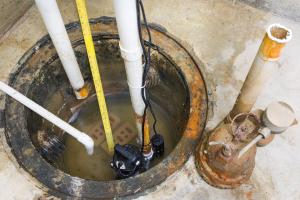Simple tips to maintain your sump pump

Many homeowners and business owners rely on a sump pump to keep water out of their basement in the event of a storm. Without the proper maintenance, however, a sump pump may fail right when you need it. Simple preventative maintenance could save you the cost of cleaning up a flooded basement. Use the following tips to help keep your sump pump in good condition, so you'll be ready in the event of a storm.
- Test the sump pump. Test the pump every year before the "wet season" in early spring to make sure it will be functioning effectively when you need it. Test the pump by pouring a bucket of water slowly into the sump pump. If the pump doesn't turn on once the water level reaches a predetermined level or if it does not properly discharge the water, then the pump may be broken or clogged. Call a licensed plumber for help.
- Clean the pump. Unplug the unit. Then, remove the pump's lid (if it has one), and use a flashlight to check inside. Remove any dirt, sand, gravel or other debris from the pump opening. If the incoming drainage lines are blocked, it becomes difficult for water to channel into the sump pit.
- Check for worn parts. A sump pump's moving parts can wear out over time, preventing the pump from operating in the event of a flooded basement. The float switch is the most common part that fails on a sump pump, and many manufacturers recommend replacing the float every two years. Also, check for corrosion and clean the inlet screen, which is located at the base of the pump.
- Install a battery backup. A battery backup will help make sure your pump doesn't fail, even in the event of a power outage. If you have battery backup installed, make sure you test the battery by unplugging the pump.
- Inspect the water discharge area. Ensure water is being directed at least 20 feet away from your house and confirm the water is flowing and not clogging along the line.
Your sump pump will display some distinct characteristics if it needs to be repaired or replaced. Contact a professional if you encounter any of these signs:
- Aging. Experts recommend that you replace an average-use unit every 7-10 years. If your pump runs frequently, its lifespan ranges from 5-7 years.
- Odors. If rotten, moldy smells are coming from your basement, your sump pump may be malfunctioning.
- Rust. An older pump may not have been made with rust-resistant materials. A pump with rust that can't be scrubbed away needs to be replaced or the rusted part needs to be repaired.
- Noises. Sump pumps shouldn't generate loud noises. If your pump is making unusual noises, like humming, clanging or banging, it could be time for a replacement.
- Water. The most noticeable sign your sump pump needs repair or replacement is the presence of water in your basement. If there is water in your basement, the pump isn't doing its job.
Keep yourself covered
Even if you perform routine maintenance, your pump might still fail, potentially causing thousands of dollars of damage. Basic home coverage doesn't always cover pump fails. Consider water backup coverage to keep your assets protected in the event of a failed sump pump.
Sources:
The Spruce
Bobvila.com
Home Advisor
Related resources
Simple tips to maintain your sump pump
Many homeowners and business owners rely on a sump pump to keep water out of their basement in the event of a storm. Without the proper maintenance, however, a sump pump may fail right when you need it. Simple preventative maintenance could save you the cost of cleaning up a flooded basement. Use the following tips to help keep your sump pump in good condition, so you'll be ready in the event of a storm.
- Test the sump pump. Test the pump every year before the "wet season" in early spring to make sure it will be functioning effectively when you need it. Test the pump by pouring a bucket of water slowly into the sump pump. If the pump doesn't turn on once the water level reaches a predetermined level or if it does not properly discharge the water, then the pump may be broken or clogged. Call a licensed plumber for help.
- Clean the pump. Unplug the unit. Then, remove the pump's lid (if it has one), and use a flashlight to check inside. Remove any dirt, sand, gravel or other debris from the pump opening. If the incoming drainage lines are blocked, it becomes difficult for water to channel into the sump pit.
- Check for worn parts. A sump pump's moving parts can wear out over time, preventing the pump from operating in the event of a flooded basement. The float switch is the most common part that fails on a sump pump, and many manufacturers recommend replacing the float every two years. Also, check for corrosion and clean the inlet screen, which is located at the base of the pump.
- Install a battery backup. A battery backup will help make sure your pump doesn't fail, even in the event of a power outage. If you have battery backup installed, make sure you test the battery by unplugging the pump.
- Inspect the water discharge area. Ensure water is being directed at least 20 feet away from your house and confirm the water is flowing and not clogging along the line.
Your sump pump will display some distinct characteristics if it needs to be repaired or replaced. Contact a professional if you encounter any of these signs:
- Aging. Experts recommend that you replace an average-use unit every 7-10 years. If your pump runs frequently, its lifespan ranges from 5-7 years.
- Odors. If rotten, moldy smells are coming from your basement, your sump pump may be malfunctioning.
- Rust. An older pump may not have been made with rust-resistant materials. A pump with rust that can't be scrubbed away needs to be replaced or the rusted part needs to be repaired.
- Noises. Sump pumps shouldn't generate loud noises. If your pump is making unusual noises, like humming, clanging or banging, it could be time for a replacement.
- Water. The most noticeable sign your sump pump needs repair or replacement is the presence of water in your basement. If there is water in your basement, the pump isn't doing its job.
Keep yourself covered
Even if you perform routine maintenance, your pump might still fail, potentially causing thousands of dollars of damage. Basic home coverage doesn't always cover pump fails. Consider water backup coverage to keep your assets protected in the event of a failed sump pump.
Sources:
The Spruce
Bobvila.com
Home Advisor
Related resources
Simple tips to maintain your sump pump
Many homeowners and business owners rely on a sump pump to keep water out of their basement in the event of a storm. Without the proper maintenance, however, a sump pump may fail right when you need it. Simple preventative maintenance could save you the cost of cleaning up a flooded basement. Use the following tips to help keep your sump pump in good condition, so you'll be ready in the event of a storm.
- Test the sump pump. Test the pump every year before the "wet season" in early spring to make sure it will be functioning effectively when you need it. Test the pump by pouring a bucket of water slowly into the sump pump. If the pump doesn't turn on once the water level reaches a predetermined level or if it does not properly discharge the water, then the pump may be broken or clogged. Call a licensed plumber for help.
- Clean the pump. Unplug the unit. Then, remove the pump's lid (if it has one), and use a flashlight to check inside. Remove any dirt, sand, gravel or other debris from the pump opening. If the incoming drainage lines are blocked, it becomes difficult for water to channel into the sump pit.
- Check for worn parts. A sump pump's moving parts can wear out over time, preventing the pump from operating in the event of a flooded basement. The float switch is the most common part that fails on a sump pump, and many manufacturers recommend replacing the float every two years. Also, check for corrosion and clean the inlet screen, which is located at the base of the pump.
- Install a battery backup. A battery backup will help make sure your pump doesn't fail, even in the event of a power outage. If you have battery backup installed, make sure you test the battery by unplugging the pump.
- Inspect the water discharge area. Ensure water is being directed at least 20 feet away from your house and confirm the water is flowing and not clogging along the line.
Your sump pump will display some distinct characteristics if it needs to be repaired or replaced. Contact a professional if you encounter any of these signs:
- Aging. Experts recommend that you replace an average-use unit every 7-10 years. If your pump runs frequently, its lifespan ranges from 5-7 years.
- Odors. If rotten, moldy smells are coming from your basement, your sump pump may be malfunctioning.
- Rust. An older pump may not have been made with rust-resistant materials. A pump with rust that can't be scrubbed away needs to be replaced or the rusted part needs to be repaired.
- Noises. Sump pumps shouldn't generate loud noises. If your pump is making unusual noises, like humming, clanging or banging, it could be time for a replacement.
- Water. The most noticeable sign your sump pump needs repair or replacement is the presence of water in your basement. If there is water in your basement, the pump isn't doing its job.
Keep yourself covered
Even if you perform routine maintenance, your pump might still fail, potentially causing thousands of dollars of damage. Basic home coverage doesn't always cover pump fails. Consider water backup coverage to keep your assets protected in the event of a failed sump pump.
Sources:
The Spruce
Bobvila.com
Home Advisor
Related resources
Simple tips to maintain your sump pump
Many homeowners and business owners rely on a sump pump to keep water out of their basement in the event of a storm. Without the proper maintenance, however, a sump pump may fail right when you need it. Simple preventative maintenance could save you the cost of cleaning up a flooded basement. Use the following tips to help keep your sump pump in good condition, so you'll be ready in the event of a storm.
- Test the sump pump. Test the pump every year before the "wet season" in early spring to make sure it will be functioning effectively when you need it. Test the pump by pouring a bucket of water slowly into the sump pump. If the pump doesn't turn on once the water level reaches a predetermined level or if it does not properly discharge the water, then the pump may be broken or clogged. Call a licensed plumber for help.
- Clean the pump. Unplug the unit. Then, remove the pump's lid (if it has one), and use a flashlight to check inside. Remove any dirt, sand, gravel or other debris from the pump opening. If the incoming drainage lines are blocked, it becomes difficult for water to channel into the sump pit.
- Check for worn parts. A sump pump's moving parts can wear out over time, preventing the pump from operating in the event of a flooded basement. The float switch is the most common part that fails on a sump pump, and many manufacturers recommend replacing the float every two years. Also, check for corrosion and clean the inlet screen, which is located at the base of the pump.
- Install a battery backup. A battery backup will help make sure your pump doesn't fail, even in the event of a power outage. If you have battery backup installed, make sure you test the battery by unplugging the pump.
- Inspect the water discharge area. Ensure water is being directed at least 20 feet away from your house and confirm the water is flowing and not clogging along the line.
Your sump pump will display some distinct characteristics if it needs to be repaired or replaced. Contact a professional if you encounter any of these signs:
- Aging. Experts recommend that you replace an average-use unit every 7-10 years. If your pump runs frequently, its lifespan ranges from 5-7 years.
- Odors. If rotten, moldy smells are coming from your basement, your sump pump may be malfunctioning.
- Rust. An older pump may not have been made with rust-resistant materials. A pump with rust that can't be scrubbed away needs to be replaced or the rusted part needs to be repaired.
- Noises. Sump pumps shouldn't generate loud noises. If your pump is making unusual noises, like humming, clanging or banging, it could be time for a replacement.
- Water. The most noticeable sign your sump pump needs repair or replacement is the presence of water in your basement. If there is water in your basement, the pump isn't doing its job.
Keep yourself covered
Even if you perform routine maintenance, your pump might still fail, potentially causing thousands of dollars of damage. Basic home coverage doesn't always cover pump fails. Consider water backup coverage to keep your assets protected in the event of a failed sump pump.
Sources:
The Spruce
Bobvila.com
Home Advisor





